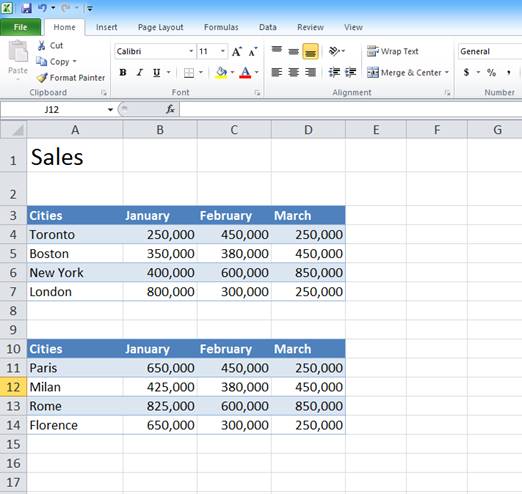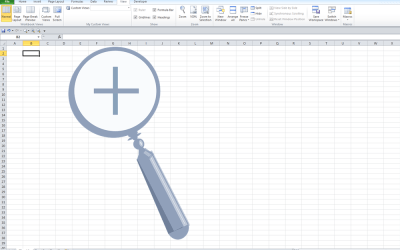Navigate Quickly using Keyboard Shortcuts in Microsoft Excel
by Avantix Learning Team | Updated April 5, 2021
Applies to: Microsoft® Excel® 2010, 2013, 2016, 2019 and 365 (Windows)
In Microsoft Excel, you can save lots of time if you can move around quickly in your worksheets and workbooks. You can use keyboard shortcuts to jump to the beginning or end of your worksheet and move up or down by ranges of data. In this article, we've put together a great list of navigation shortcuts to help you be more productive with Excel.
Recommended article: 10 Timesaving Selection Shortcuts in Microsoft Excel Worksheets
Do you want to learn more about Excel? Check out our virtual classroom or live classroom Excel courses >
1. Go home (go to the top left cell)
Pres Ctrl + Home to move to the top left cell in the current worksheet below the frozen titles which is usually cell A1.
2. Go to a specific cell
Press Ctrl + G and the Go To dialog box appears. Type the cell reference in the reference area and press Enter to go to that cell.
3. Move to the next sheet
Press Ctrl + Page Up to move to the next sheet in the current workbook.
4. Move to the previous sheet
Press Ctrl + Page Down to move to the previous sheet in the current workbook.
5. Move up by data area
To move up by data area, press Ctrl + up arrow. Repeat to move up to the next area with data.
6. Move down by data area
To move down by data area, press Ctrl + down arrow. Repeat to move down to the next area with data.
7. Move right by data area
To move right by data area, press Ctrl + right arrow. Repeat to move right to the next area with data.
8. Move left by data area
To move left by data area, press Ctrl + left arrow. Repeat to move right to the next area with data.
9. Move to a named cell or range using the Go To dialog box
If you have a cell or range of cells on a sheet that you want to jump to quickly, you can name the cells or ranges and then quickly jump to them.
To name a cell or range of cells and then jump to it:
- Select a cell or range of cells.
- Press Ctrl + F3 (some users may need to press Ctrl + Fn + F3). The Name dialog box appears.
- Press N for New.
- Enter a name (such as Toronto). Names can't have spaces. Excel will suggest the current cell or range as an absolute reference and the current sheet.
- Press Enter.
- Press Ctrl + G. Any named cells or ranges will appear in the dialog box.
- Click or tab to the named cell or range (such as Toronto) you wish to jump to and press Enter.
10. Move to a named cell or range using the Name box
If you have created a named cell or range, you can jump to it using the Name box (in the left area of the Formula bar):
- Click the down arrow in the Name box (you will need to have named cells or ranges in the workbook).
- Select the named cell or range from the drop-down menu.
This article was first published on July 9, 2014 and has been updated for clarity and content.
Subscribe to get more articles like this one
Did you find this article helpful? If you would like to receive new articles, join our email list.
More resources
How to Use Flash Fill in Excel (4 Ways with Shortcuts)
How to Use Cell Styles in Excel to Save Time Formatting
How to Freeze Row and Column Headings in Excel Worksheets
3 Excel Strikethrough Shortcuts to Cross Out Text or Values in Cells
How to Replace Blank Cells with a Value from the Cell Above in Excel
Related training
Microsoft Excel: Intermediate / Advanced
Microsoft Excel: Data Analysis with Functions, Dashboards and What-If Analysis Tools
Microsoft Excel: Introduction to Power Query to Get and Transform Data
Microsoft Excel: New and Essential Features and Functions in Excel 365
Microsoft Excel: Introduction to VBA (Visual Basic for Applications)
Our instructor-led courses are delivered in virtual classroom format or at our downtown Toronto location at 18 King Street East, Suite 1400, Toronto, Ontario, Canada (some in-person classroom courses may also be delivered at an alternate downtown Toronto location). Contact us at info@avantixlearning.ca if you'd like to arrange custom instructor-led virtual classroom or onsite training on a date that's convenient for you.
Copyright 2024 Avantix® Learning
YOU MAY ALSO LIKE
What is Power Query in Excel?
Power Query in Excel is a powerful data transformation tool that allows you to import data from many different sources and then extract, clean, and transform the data. You will then be able to load the data into Excel or Power BI and perform further data analysis. With Power Query (also known as Get & Transform), you can set up a query once and then refresh it when new data is added. Power Query can import and clean millions of rows of data.
How to Stop or Control Green Error Checking Markers in Excel
In Microsoft Excel, errors are flagged with small green marker or triangle in the upper left corner of the cell. However, these indicators display when there may be an error but is, in fact, not an error.
Excel Shortcuts to Zoom In and Out in Your Worksheets (4 Shortcuts)
There are several mouse and keyboard shortcuts you can use to zoom in and out in Excel worksheets. Some of these shortcuts are built-in and others can be created by customizing Excel Options.
Microsoft, the Microsoft logo, Microsoft Office and related Microsoft applications and logos are registered trademarks of Microsoft Corporation in Canada, US and other countries. All other trademarks are the property of the registered owners.
Avantix Learning |18 King Street East, Suite 1400, Toronto, Ontario, Canada M5C 1C4 | Contact us at info@avantixlearning.ca







